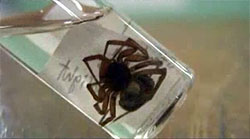 |
 |
|
The CWU Health Safety and Environment Department has re-issued a warning first sent to CWU Branches in 2009 over a rise in UK's most dangerous spider due to milder winters which has led to the rapid rise in numbers of the "False Black Widow Spider" A news item regarding this type of spider, along with a reported case of illness due to an allergic reaction to a bite from this spider, was also featured on this website. The warning, in LTB862/11 is reproduced in full below:
It may be no bigger than a pea, but its bite can put a grown man in hospital. The "False Black Widow Spider" species, officially called steatoda nobilis, originally came from the Canary and Madeira Islands over a 100 years ago probably in a cargo of bananas. The species had kept a low profile since arriving and it's been established in Devon for a long time but in recent years has been rapidly spreading along the south coast and up the to east of England and is likely to spread northwards in years to come according to insect experts at the Natural History Museum. This elegant spider has a black/brown bulbous abdomen with pale markings and the females grow to 15mm. They live in walls, fences and the barks of trees and eat insects, other invertebrates and even other spiders. It is closely related to the black widow spider whose poison can be fatal to humans. It poses a threat to gardeners and anyone else working or spending leisure time outdoors. Their nest is small, round, white & is about the same size as a table-tennis ball. They are found inside houses also. Gardeners and Outdoor workers have been warned to be on their guard in the future. A bite from the False Black Widow Spider delivers enough poison to cause severe pain and inflammation. The severity of symptoms from any spider bite depends on the amount of venom that is injected. Also flu-like symptoms, aches, sweats, fatigue, perspiring, cold and shaky, chest pains, swelling and tingling of fingers are some of the symptoms which can be experienced. One study found that the pain was far more severe than that from a wasp or bee sting. Normally an antihistamine tablets and cream will take the pain away but, depending on the amount of venom injected, a doctor may need to be seen. The spiders have previously been found in communications and electricity boxes so engineers and electricians should head the warning. There's no need to panic however, just be aware. Despite increased numbers and range the likelihood of being bitten by a False Black Widow Spider remains very low. Videos of the False Black Widow Spider can be found here and here Source: CWU |
 Experts have concluded that the milder winters and year on year, record breaking hot summers in the UK are keeping more of the spiders alive. It used to be only a handful of spiders that would survive the cold weather so the numbers were always kept down. But now they are all surviving the winter and are crawling out of hibernation earlier to mate. The result has been numbers have just rocketed into the hundreds of thousands. The species - only the female of which bites - had been considered native to Devon and Dorset but has spread as far as East Anglia. Recent reports of bites by BT members are in Canvey Island Essex. The spider usually lives on walls, fences and tree bark.
Experts have concluded that the milder winters and year on year, record breaking hot summers in the UK are keeping more of the spiders alive. It used to be only a handful of spiders that would survive the cold weather so the numbers were always kept down. But now they are all surviving the winter and are crawling out of hibernation earlier to mate. The result has been numbers have just rocketed into the hundreds of thousands. The species - only the female of which bites - had been considered native to Devon and Dorset but has spread as far as East Anglia. Recent reports of bites by BT members are in Canvey Island Essex. The spider usually lives on walls, fences and tree bark.